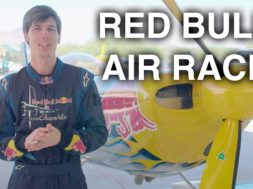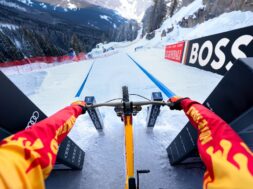Red Bull Air Race – Najbardziej intensywne doświadczenie w moim życiu
The power plant of the Edge 540 is an air-cooled six cylinder horizontally opposed engine. The engine code, AEIO540, indicates that the engine is aerobatic (AE), as in the plane can fly upside down with both oil and fuel pressure maintained, the “I” stands for fuel injection, the “O” for horizontally opposed, and 540 for the displacement of the engine in cubic inches. The engine produces 300 horsepower, and while the specific output may seem low, it’s important to realize that reliability is a much more important factor here, with the large displacement engine having relatively low internal stresses. There are also two ignition systems as redundancy for safety.
From the engine, the propeller is directly driven by the crankshaft – there’s no gearbox or gear reduction used, and the engine speed is limited to 2,950 RPM for competition. To optimize the engine speed for competition, a governor is used to maintain the peak propeller RPM. The governor works by altering oil pressure within the propeller, changing the pitch of the blades. The pitch, or angle of attack of the blades, is very much so like the gearing of a car. A fine (or low) pitch is similar to using a lower gear with a high ratio, great for initial acceleration but with a low top speed. A course (or high) pitch is similar to a higher transmission gear with a lower ratio – more efficient and it allows for traveling at higher speeds. The pitch is adjusted constantly to maintain the peak 2950 RPM. From an engineering standpoint, it operates in a similar manner to a continuously variable transmission.
The plane is incredibly light, and yet incredibly rigid. Including the driver, fuel, everything – the plane has a minimum weight of 696 kg, or about 1535 lbs. For comparison, that’s significantly less than a Smart Car, yet with a massive 8.8 liter engine. This ultra-light structure is capable of withstanding up to the 12 g’s of acceleration allowed in competition, and the pilots may sustain anywhere from 6-8 g’s in a long bend. Much like in auto racing where drivers try to stay on the edge of grip, pilots will attempt to get as close to the 12 g mark without crossing over during the race to put down the fastest time.
The plane consists of a steel tube fuselage, and the engineers aim to push the center of gravity of the plane as far back as possible. This makes the plane unstable, but it greatly improves the agility, which is what the pilots want.
Aerodynamics, as you might assume, play a crucial role in competition. While the two seater version of the plane has open wing tips, the competition plane features tips that reduce the influence of vortices disrupting the airflow over the wing, greatly reducing drag. Less drag means the plane can fly faster, and accelerate harder. One of the spots Red Bull has recently innovated is the rudder behind the rear stabilizer. They’ve reduced the size by about 33%, significantly cutting down on drag.
All of the flight controls for rotating the plane are completely man powered. There’s no electronics or hydraulics to assist in maneuvering the plane. Kirby Chambliss will control the rudder with his feat, and the ailerons (or wing flaps), with his hands. One of the features on the wings you might notice are the spades, which connect to the ailerons. These spades act as an air brake, essentially providing an assist when altering the orientation of the ailerons to maneuver the plane. In principle, the idea is very similar to power steering in a car, because as he rotates the aileron, the spade creates a force to help this rotation.
There are also some clever features from a safety standpoint. For example, if the plane were to center punch one of the pylons used in competition, this could block airflow to the engine. No air and the engine dies, and now the pilot has to land without any power. To prevent the engine from stalling, an air flap is located just behind the air intake, and the vacuum of the engine will force this open so surrounding air can feed it. There are enough openings around the engine that the airflow will be sufficient to keep the engine running. There are also cutters on the plane incase a pylon is hit in other locations. Cutters between the spade and the ailerons ensure nothing gets caught in this area, and there are also cutters between the fin and the rudder.
10










